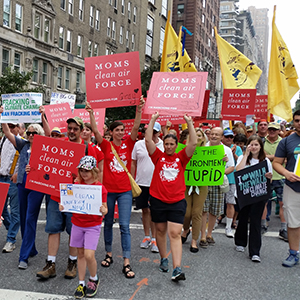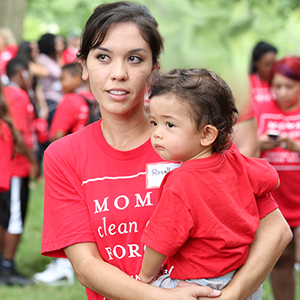By: Moms Clean Air Force
Date: March 2024
About: Docket ID No. EPA–HQ–OA–2024–0043
To: Environmental Protection Agency
The NEYAC was established to provide guidance on addressing a range of environmental issues as they relate to youth. Moms Clean Air Force is particularly concerned about the intersection between plastics, petrochemicals, the climate crisis, and young people’s health. Young people now are among the first generations to have been impacted by plastics over the course of their entire lives—from birth to now, from plastic baby bottles to plastic-infused clothing. The impacts of plastic and petrochemicals range from the harms of living in communities near petrochemical facilities, which spew out pollution linked to childhood cancers and numerous other health risks, to the hazards of microplastics in food and drinking water. Recent research has documented microplastics in virtually every part of the human body, including placentas and breastmilk, and a landmark study published this month links exposure to microplastics to serious health harms. There is much we still don’t know about the health impacts of microplastics, but it’s difficult to imagine that future research will ease our concerns.
We know that the fossil fuel industry is on track to triple plastics production by 2050, which would exponentially increase climate-heating greenhouse gas pollution and vastly expand the already-troubling health harms of plastic. Plastics and petrochemicals will be a defining issue for the current generation of youth, but taking bold action now may prevent the situation from getting dramatically worse for generations to come. Curbing the production of plastics and petrochemicals must be central to EPA’s vision and approach to addressing intergenerational justice and ensuring a safe, healthy environment for today’s young people and future generations.
In addition, actions to mitigate the climate crisis by swiftly reducing greenhouse gas emissions are essential to protecting the well-being of young people now and in the coming decades. As the climate crisis erodes years of Clean Air Act-driven progress on cleaning up harmful pollutants like particle pollution and ozone, robust action to address air pollution is critical to protecting developing lungs.
Moms Clean Air Force commends EPA on a year of unprecedented momentum in rulemakings designed to protect communities from the impacts of climate change and harmful air pollution. We ask EPA to keep this momentum going, with particular attention to the following:
Topic 1: Advancing environmental justice in communities
Moms Clean Air Force strongly supports robust action to advance environmental justice in communities, given the disproportionate impact of climate change, air pollution, and other environmental hazards to the health of Black, Latino, and Indigenous communities and other communities of color. We ask EPA to pay particular attention to the following areas of focus:
- Addressing environmental justice communities affected by petrochemical pollution: Many of the people hardest hit by the impacts of climate change live in the southern and eastern parts of the U.S. Those who are living near petrochemical production and plastic incineration facilities are particularly vulnerable since they face the interconnected risks from petrochemical air pollution and climate disasters—everything from pipelines bursting in extreme heat to startup, shutdown, and malfunction events, in which facilities release massive amounts of uncontrolled hazardous air pollution in anticipation of hurricanes, tornadoes, and other climate-related disasters. EPA must take ambitious action to protect communities disproportionately burdened by petrochemical pollution; see comments under topic 2 for specific suggestions.
- Finalizing strong rulemakings in spring 2024: We thank EPA for finalizing a strong methane rule in December and updating the NAAQS for annual PM2.5 in February. And we were pleased to see the added protections in the Risk Management Program rule. Now, it is critical that EPA finalize several other important rulemakings as soon as possible. We ask you to finalize the strongest possible emissions standards for light- and medium-duty vehicles and for heavy-duty vehicles. We ask you to finalize robust Mercury and Air Toxics Standards. We urge EPA to finalize the strongest possible rules for chemical manufacturing (Hazardous Organic NESHAPS) facilities. And we ask you to finalize strong carbon pollution protections for existing and new coal plants and new gas power plants. Black, Hispanic, and Indigenous communities of color are particularly impacted by climate change and by air pollution from vehicles, power plants, and industrial facilities because of historically discriminatory housing practices like redlining and other forms of systemic racism. Each of these rulemakings is critical to advancing environmental justice in communities.
- Maintaining strong Clean Air Act protections for environmental justice communities: We urge EPA not to gut the Clean Air Act’s critical protections for environmental justice communities. Specifically, we ask EPA to reverse the Trump-era rule that would allow major sources of hazardous air pollutants to reclassify as minor sources, thereby bypassing important pollutant controls that are critical for communities’ health and safety. In addition, we ask EPA to withdraw the proposed lime kiln rule that would reverse the Clean Air Act’s critical precautionary principle that hazardous air pollutants must be controlled unless EPA shows they do not cause cancer. Finally, we ask EPA to withdraw the proposed Title V rule eliminating EPA review of federal air permits, as communities rely on EPA to ensure that polluters comply with Clean Air Act protections.
- Addressing pollution from existing natural gas power plants: We thank EPA for listening to community input, and particularly input from environmental justice leaders, regarding the need for a more comprehensive plan for addressing pollution from existing natural gas power plants. Please do not delay in moving forward a separate rulemaking to address this pollution.
- Addressing ozone pollution: We were disappointed by the delay in updating the NAAQS for ozone last year. Ozone pollution is extremely harmful to children’s health, contributing to respiratory harm and adverse birth outcomes. In addition, systemic racism has created practices that force Black, Latino, Indigenous, and other families of color to live in places that are disproportionately harmed by ozone, such as urban heat islands or housing located near pollution sources, like heavily trafficked roads, factories, or ports, making addressing ozone pollution an important environmental justice priority. We strongly encourage EPA to move forward with the next step in reconsidering the Ozone NAAQS as quickly as possible and to convene a public science and policy workshop in the spring of 2024 to gather input from the scientific community and the public.
- Promoting Black and Latina maternal and child health: Black mothers and infants are disproportionately impacted by environmental hazards like extreme heat and air pollution, and have higher maternal and infant mortality rates than other racial groups, irrespective of socioeconomic status. Latina mothers and infants are also disproportionately harmed by extreme heat and air pollution. We strongly recommend that EPA add indicators related to maternal and child health to the Climate and Economic Justice Screening Tool.
- Promoting language equity: Latino and immigrant communities are often on the front lines of the climate crisis. When extreme weather hits, it is critical that important emergency information be accessible in the languages that individuals and families most easily understand. Information about languages spoken at home may help public health officials identify communities with particular need for emergency materials and other important forms of climate communication that are available in languages other than English. We strongly recommend that EPA include indicators related to language spoken at home to the Climate and Economic Justice Screening Tool.
Topic 2: Protecting communities addressing climate change and reducing harmful emissions
- Plastics and petrochemicals: Plastics and other petrochemicals are the world’s fastest-growing industrial source of greenhouse gases, and Moms Clean Air Force is profoundly concerned about how this is contributing to the climate crisis and generating dangerous pollution for communities living near petrochemical facilities. Every step of the plastics supply chain releases greenhouse gases and other harmful pollutants—from extraction of the fossil gases that become the building blocks of plastics to processing, production, transport, use, and incineration.
- The fossil fuel industry is on track to triple plastics production by 2050, which would exponentially increase greenhouse gas pollution. Without immediate action to stem the production of unnecessary single-use plastics, human well-being will be in serious jeopardy from the cascading impacts of climate change—such as floods, heat waves, droughts, and acute water and food insecurity.
- In addition, as noted above under comments for Topic 1, many of the people hardest hit by the impacts of climate change live in southeastern states like Louisiana and Texas, a region of the country facing significant climate threats. Communities located near petrochemical production and plastic incineration facilities face the interconnected risks from petrochemical air pollution and climate disasters.
- Specifically, we ask EPA to continue moving forward with the following actions without delay:
- Strengthen the National Plastics Strategy, per comments delivered to EPA in July 2023 by Moms Clean Air Force with the support of 119 other organizations in the Break Free From Plastics coalition.
- Cap and ultimately reduce plastics production.
- Establish full transparency of toxic chemicals at every stage in plastics processing, manufacture, and transport;
- Ban the most toxic polymers and plastics chemicals, including vinyl chloride;
- Strengthen and enforce laws protecting people at every step of the supply chain, from fossil extraction to petrochemical processing, manufacture, use, transport, and disposal;
- Address the harm that plastics are inflicting on our planet and our climate; and
- Accelerate the transition to safer processes and to materials and products not made from fossil fuels and toxic chemicals.
- Air Quality Index: Moms Clean Air Force is disappointed that the 24-hour standard for particle pollution was not updated in the recent revision to the PM2.5 NAAQS, as this impacts the Air Quality Index that families and communities around the country use to determine whether the air outside is safe to breathe. Specifically, we are disappointed that the beginning breakpoint for the orange (“unhealthy for sensitive groups”) category on the AQI that designates that the air quality is unhealthy for sensitive groups does not reflect what many public health professionals believe is current science about the health impacts of safe limits of exposure to PM2.5 during a 24-hour period; EPA’s own CASAC and numerous other public health groups strongly supported a 24-hour limit for PM2.5 of 25 micrograms per cubic meter. We ask EPA to take the following actions:
- Strengthen public messaging related to the AQI to clearly indicate that babies, children, and pregnant people are considered “sensitive groups” in guidance around the orange AQI level. This public messaging is currently not clear enough.
- Provide clearer guidance for parents and child care providers on how to keep babies and children safe when the air quality is considered “moderate,” given strong science suggesting that when PM2.5 levels go above 25 mcg/m3, which is well within the “moderate” AQI breakpoints, children’s health is at risk.
- Access to mental health care: In addition to its impact on physical health, climate change increasingly threatens mental health as well, and many communities lack adequate mental health care infrastructure. Having readily-accessible information about communities’ level of access to mental health care (e.g., number of licensed mental health care professionals in a given census tract) may help public health officials identify communities that would particularly benefit from initiatives designed to build mental and emotional resilience, such as funding for community resilience programs, like those described in the Community Mental Wellness and Resilience Act. We strongly recommend that EPA add indicators related to access to mental health care to the Climate and Economic Justice Screening Tool.
- Finalize strong rulemakings in spring 2024: See comments under Topic 1.
- Address pollution from existing natural gas power plants: See comments under Topic 1.
- Address ozone pollution: See comments under Topic 1.
Topic 3: Advancing the circular economy by reducing food loss and waste, and increasing recycling
Moms Clean Air Force strongly supports movement towards a circular economy via reducing food loss and waste and increasing recycling of metals, paper, and glass. We also strongly encourage EPA to resist industry greenwashing and promises of false solutions to our collective waste crisis, as these false solutions may inadvertently contribute to further harm in communities already overburdened by pollution.
- EPA’s suggested “plastics circular economy” is an illusory idea. The reality is that plastics are part of a linear system that starts with oil, gas, and sometimes coal, and ends with incineration, landfill, and plastic pollution in the soils and waterways. Even with the best of intentions it is not possible to make plastics into a circular commodity given the toxic nature of its constituents. A 2021 assessment found 10,000 chemicals added to plastics, 2,400 of which meet the criteria for toxicity, bioaccumulation, or persistence. In other words, these chemicals are known to harm human health and the environment. EPA allows 667 of these chemicals of concern for use in food-contact plastics alone, and many more in cosmetics and other consumer uses. A May 2023 UNEP Technical Report determined that the number of chemicals in plastic is actually over 13,000.
- Plastics recycling is a mechanical process that consists of sorting, grinding, and melting plastic waste, and combining it with virgin plastic to make new plastic products. Mechanical plastic recycling is not technically or economically viable—it hardly works and never will, given the thousands of synthetic chemicals and polymers (in countless combinations) found in plastic. Not only does plastics recycling involve its own internal roadblocks, but plastics materials contaminate the valuable waste streams that can be successfully recycled, such as metals, glass, and paper. The plastics recycling process pollutes waterways with PFAS and other chemicals and with microplastic particles; exposes workers to high concentrations of airborne plastics; and leads to elevated concentrations of toxic chemicals in the recycled plastic products. These realities have not stopped the plastics industry from waging a decades-long campaign of fraud and deception to convince Americans that plastics recycling is the solution to the plastic crisis.
- “Chemical recycling”: We also want to call EPA’s attention to the hazards of what the plastics industry calls “chemical recycling,” also known as “advanced recycling.” Touted as a solution to the plastics waste crisis, this process is neither advanced nor is it recycling. It is a form of plastics incineration that generates harmful air pollution, contaminated oil, and toxic ash. By deceptively presenting plastics incineration as an environmentally sound solution, the plastics industry seeks to justify its plans to triple plastics production by 2050.
- The plastics industry lobby is trying to convince state and federal lawmakers, as well as EPA, that burning plastics in “chemical recycling” facilities should not count as incineration. They want to change the classification of “chemical recycling” from incineration to “manufacturing” or “recycling,” or to redefine plastic trash as “not solid waste,” as a way to evade air pollution controls. Such a determination would leave companies free to emit unlimited amounts of harmful air pollution without any monitoring, reporting, or control technologies. In addition, if reclassified, many of these facilities would qualify for subsidies and tax breaks. Already more than two dozen states have passed laws promoting “chemical recycling.”
Movement towards a circular economy is essential, but embracing false solutions that amplify harm to communities already overburdened by petrochemical pollution is both unsustainable and unjust.
Sources:
- https://www.momscleanairforce.org/resources/petrochemical-pollution-and-our-health/
- https://www.nature.com/articles/d41586-024-00650-3
- https://www.momscleanairforce.org/wp-content/uploads/2023/08/Break-Free-From-Plastic-EPA-Draft-National-Strategy-Sign-on-Letter.pdf
- https://www.lung.org/getmedia/a951f185-8477-4fd0-8491-ccfe33535c5d/GroupComments_PM25NAAQS_ProposedRule-Updated-Health-Org-Signers-10-9-23.pdf
- https://www.momscleanairforce.org/resources/ozone-pollution-101/
- https://www.momscleanairforce.org/resources/plastics-and-climate-change/
- https://www.momscleanairforce.org/resources/chemical-recycling-101/




